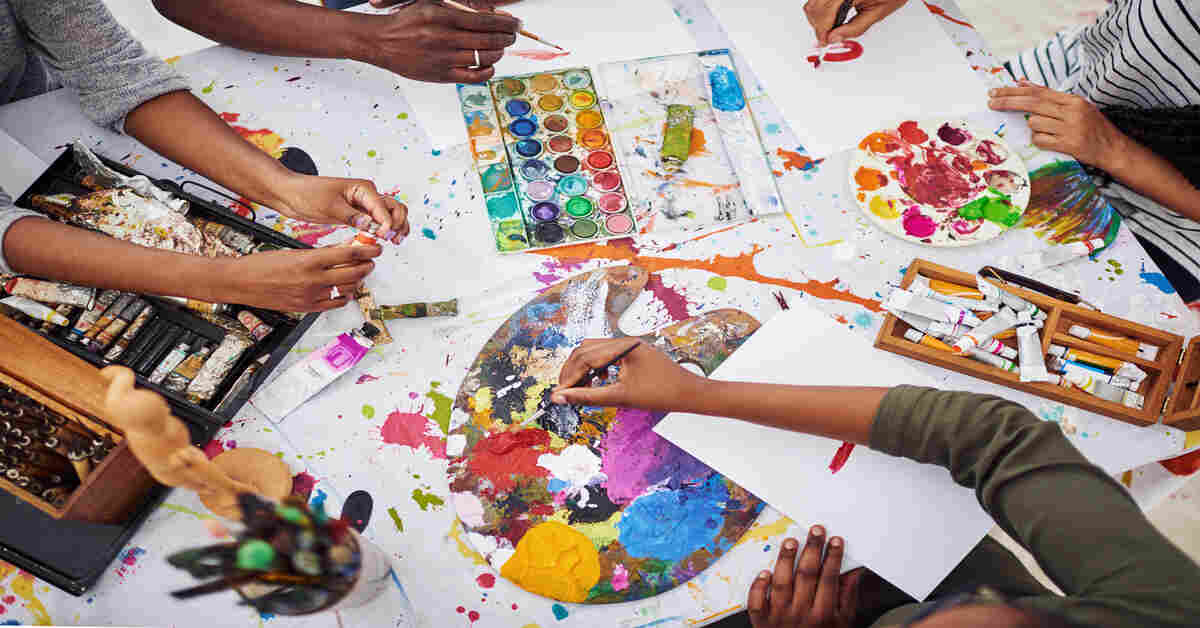Festival Culture November 12, 2025

How Do Artists Shape and Transform Our Social Landscape?
Art is far more than decoration or entertainment, it’s the heartbeat of civilization. Since the paintings on the cave walls and our digital images, art has influenced the way we perceive ourselves, our societies, and the environment we live in. Knowledge of the role of Art in Society is critical since it demonstrates how creativity alters thinking, leads to innovation, and cultural development.
This educational investigation explores extensively the role of art in education, social values, and advancement, and the reason artists have been and continue to be one of the most significant agents of human evolution.
1. The Historical Role of Art in Society
Art has always reflected the experience of man. Painting, sculptures, and architecture were used in ancient civilizations to record the belief, conquests, and customs. The purpose of Art in the Society at these periods was to teach, inspire and to eternalize the memory of groups.
- In Ancient Egypt, art acted as a pictorial theology, representing divinities, the concepts of afterlife and royal authority.
- In Rome and Greek, it represented the perfection of humans, philosophy and democracy.
- During the Renaissance, the arts served as a form of connection between science and religion, a combination of realism and divine ideology.
Throughout history, art was not only an indicator of culture but it was culture. Every masterpiece, such as Michelangelo Sistine Chapel or Picasso Guernica has had a message regarding human rights, freedom, and feeling. This development is the key to understanding the current Role of Art in Society.
2. Art as a Mirror and Messenger
Art is a reflection of reality, yet it is also a challenge to reality. The Role of Art in Society goes as far as the voice of the voiceless – a social commentary that raises eyebrows and causes discussions.
Artists are also messengers of change, and they tend to discuss such issues as injustice, inequality, and environmental degradation. Consider:
- Banksy, the artist who challenges authority through his street art.
- Frida Kahlo who transformed her personal suffering into a political statement.
- Ai Weiwei, a Chinese artist who is an activist of human rights.
Artists challenge society to reflect, debate and change through colors, symbols, and the design. Art therefore is not just aesthetic enjoyment, but also a means of awareness.
3. The Educational Value of Art
Role of Art in Society is studied in schools and universities to assist students in learning emotional intelligence, critical thinking, and cultural literacy. It is not only an art-education that teaches techniques, but a sense of meaning and outlook, history.
Here’s how art enriches education:
- Promotes Creativity: The students are taught to produce individual ideas in a visual and conceptual form.
- Enhances Problem-Solving Ability: Artmaking should be experimental, resilient, and flexible.
- Develops Empathy: The appreciation of global art helps to improve perception of other types of human experience.
- Improves Academic Achievement: It has been found that students who are involved in arts excel in mathematics and reading.
- Fosters Cultural Knowledge: When learners learn about world art, they learn the common narrative of humanity.
The Use of Art in Society is thus inextricably connected with education, both in terms of the formation of individuals, and of the general intelligence of generations.
4. Artists as Architects of Culture
Artists shape our ways of dressing, design, communication and even thought. It could be architecture that creates a skyline, it could be music that creates a generation, or it could be film that creates an era, but either way, creative minds create the emotional infrastructure of civilization.
Consider the Role of Art in Society through the lens of cultural impact:
- Cities are formulated by architects in a way that is inspiring and creative.
- Musicians communicate feelings that bind human beings irrespective of boundaries.
- Moviemakers break the stereotypes and stretch the empathy.
Any creative professional is a part of the unseen construct of culture, a construct that is not made of steel or glass, but imagination and meaning.
5. Art as a Tool for Social Change
One of the most powerful aspects of the Role of Art in Society is its capacity to ignite change. Throughout history, artists have used their work to influence public opinion and policy.
- The Harlem Renaissance used art to celebrate African American identity and challenge racial injustice.
- The Feminist Art Movement of the 1970s redefined gender representation in media and art.
- Environmental artists today use installations to highlight the urgency of climate action.
Art doesn’t just decorate revolutions, it drives them. Visuals often succeed where words fail, translating emotion into action.
6. The Psychological Role of Art in Society
Art fosters mental health beyond politics and culture. Art in its form of either creation or appreciation is therapeutic. Psychologists also attest that painting, drawing, and seeing art can decrease anxiety, boost the mind, and make one feel happier.
School-based, hospital-based and prison-based art therapy initiatives show that creativity can help to heal trauma and resilience. The Role of Art in Society goes as far as to emotional well-being that beauty and expression are not luxuries, but necessities of the balance in life.
7. Technology and the Evolution of Artistic Expression
With the expanding digital innovation, the Role of Art in Society is taking another turn. Technology is pushing the creative limits of virtual museums to machine-generated art.
And nowadays artists are able to reach the world with the help of such technologies as augmented reality, the use of 3D printing, and blockchain technologies. Digital platforms enable the voices of the marginalized to spread their stories all over, making art more democratic and redefining its mission.
However, this development also attracts crucial educational discussions:
- What does originality mean in the era of AI art?
- What is the ethical responsibility of digital artists?
- What can technology do to retain the ancient forms of art and still allow innovation?
The fact that these questions are addressed makes Role of Art in Society a relevant and responsible part of the modern world.
8. The Role of Museums and Institutions
One of the custodians of cultural memory is the museums, galleries, and art schools. They are critical to the role of Art in Society by keeping heritage, promoting artists and making art accessible to everyone.
These institutions turn art into private creation to a public dialogue through curated exhibitions, community workshops, and other public programs. The online museum tour that became popular during the pandemic demonstrated the fact that art is one of the most important human needs even in the state of isolation.
9. How Art Shapes Values and Identity
Art is what defines how individuals perceive themselves, and their identity within the world. The Role of Art in Society also contains the development of moral and cultural values – the promotion of compassion, respect, and inclusiveness.
Public art work, e.g. murals and sculptures, frequently reappropriates the street and brings a sense of pride to the community. School based art education assists youths to discover identity and diversity and raise citizens of the world to appreciate individuality and solidarity.
Whenever individuals come into contact with art, be it, painting, theatre, or merely seeing a sculpture, they are involved in some sort of a discussion regarding the meaning of being human.
10. Real-Life Examples of Art’s Societal Influence
To better understand the Role of Art in Society, let’s examine three powerful case studies:
- “Guernica” by Pablo Picasso – This anti-war masterpiece depicts the horrors of the Spanish Civil War and remains one of history’s strongest visual statements against violence.
- Street Art in Post-Apartheid South Africa – Murals across Johannesburg and Cape Town now serve as reminders of unity, resilience, and hope.
- Public Art for Social Awareness – Campaigns like “Fearless Girl” on Wall Street and global climate art installations prove that creative expression can drive political awareness and inspire change.
These examples show that art is not confined to galleries, it lives wherever people have something meaningful to say.
11. How to Support the Arts in Your Community
If you want to strengthen the Role of Art in Society, here are a few simple yet impactful ways to get involved:
- Attend Local Exhibitions: Support emerging artists and community galleries.
- Participate in Art Education: Enroll in art classes or encourage creative programs in schools.
- Donate or Volunteer: Contribute time or resources to art nonprofits.
- Promote Art Digitally: Share local art online to expand its reach.
- Commission or Buy Local Art: Invest directly in artists’ livelihoods.
Art thrives when communities value it. Your engagement ensures creativity continues to flourish for future generations.
12. The Future of Art and Its Societal Impact
Looking ahead, the Role of Art in Society will continue to expand as humanity faces new challenges. From climate change awareness campaigns to virtual exhibitions, art will remain a vital force for connection and progress.
Future trends suggest that:
- Art will become increasingly interdisciplinary, blending science, design, and activism.
- AI will play a role in art creation, but human emotion will remain its core.
- Education systems will integrate art more deeply into STEM subjects, forming STEAM learning (Science, Technology, Engineering, Art, and Mathematics).
As societies evolve, art will remain our most human form of communication, expressing what data and technology cannot.
FAQs
1: What is the Importance of the Role of Art in Society in Education?
In the education of art, the creation of one develops creativity, critical thinking, and empathy, which are vital skills in personal and professional development. It assists students to learn about culture, history and innovation.
2: What is the impact of art in social change?
Art provokes thinking and stimulates discussion. Murals, performances and movies tend to put societal issues into focus and bring about awareness and activism.
3: Is it possible to substitute traditional art forms with digital art?
Digital art extends the creative possibilities, not pushing out the traditional mediums. The two coexist, and this is indicative of the ever-changing Role of Art in the Society in the digital era.
Final Thoughts
The Role of Art in Society is primitive and immortal. It educates, cures, motivates and connects. Whether it is taught in the classroom or in movements around the world, art makes us aware that creativity is the basis of advancement and compassion.
The historians and philosophers and visionaries of our era are artists. Their art cuts across boundaries and cultures, with messages that define our future. When we go on learning through art, and because of it, we retain not only beauty, but the very thing that makes us human.Then the next time you look at a painting, watch a movie or listen to a song that makes your soul soar, keep in mind – you are not merely experiencing art. You are observing the soul of society in actual sense.



